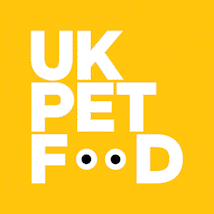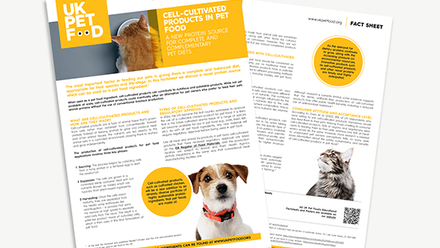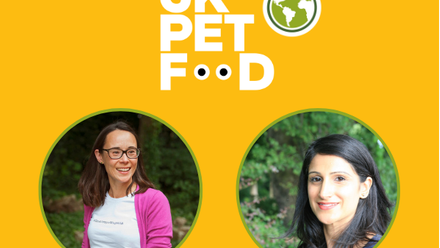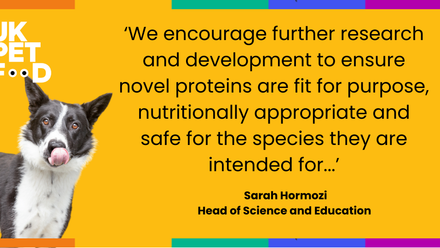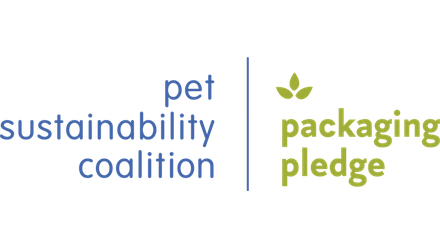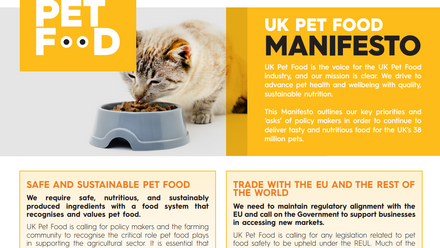Towards Circularity of Pet Food Packaging
What is Circularity?
Circularity is the highest form of recycling so that all materials in a product can be reused endlessly so no value is lost and there is no waste.
Pet Food Packaging
Pet food packaging is critical to ensure pet food is kept safe and retains its nutritional quality as products move through the supply chain from factory to pet owners. Packaging also provides pet owners with important factual and legal information about the food they are purchasing for their pets.
To continue to offer pet owners a broad choice of products in convenient formats, pet food manufacturers use different kinds of packaging. This includes cans, pouches, alu-trays and bags. There are different materials used in formulating the packaging, ranging from paper and cardboard to plastic and aluminium. Manufacturers carefully select the best option to ensure freshness, hygiene, safety, and sustainability.
All packaging materials that are in contact with food, including pet food, are subject to strict legislation to ensure safety. This naturally reduces the range of packaging materials available to pet food manufacturers.
Different pet food packaging materials face different challenges in terms of circularity. Some materials, including some plastics, are already fully recyclable. However, the challenge is to ensure infrastructure is in place to collect, sort and recycle it and that consumers dispose of the waste responsibly. For other materials, there is a need for innovation in recycling technology and sometimes redesign.
Whilst there are challenges, the pet food industry is working hard to deliver solutions and reduce the environmental impact of packaging.
Sustainable Pet Food Packaging
The pet food industry has been making progress to reduce and optimise the use of packaging materials, find sustainable alternatives to non-recyclable plastic, and increase the use of recycled content. These efforts are part of our active contribution to tackling climate change and reducing waste.
Considerations for the Pet Food Industry
1. Life-cycle Approach
We support measures to reduce and improve packaging that are based on scientific evidence and follow a life-cycle approach, recognising the role of packaging in protecting pet food safety and reducing waste.
2. Definition for Recyclability
A number of innovations are taking place to simplify packaging in order to improve its recycling performance. There is a need for a common definition of recyclability based on the potential of the packaging material to be recycled and considering existing and emerging technologies and infrastructure.
3. Infrastructure for Collection, Sorting & Recycling
The lack of a suitable sorting and recycling infrastructure within the UK requires the industry to export over 60% of existing collected material for recycling. This includes an absence of suitable non-mechanical recycling capacity to enable the full recycling of plastic packaging into the required high-value, food-safe applications.
Whilst recent innovations have led to the development of 100% recyclable pouches, currently, only 17% of UK councils collect and process this material. This is why the pet food industry actively supports the development of a well-functioning collection, sorting and recycling system. UK Pet Food is working with partners such as WRAP and FDF to help develop new approaches to facilitate this.
4. Extended Producer Responsibility
Extended Producer Responsibility (EPR) schemes are in place in a number of EU countries. Producers under these schemes are responsible for the management of waste, which includes the collection of used goods and sorting and treatment of their recycling. EPR schemes should be enhanced to increase packaging waste collection and sorting.
5. Recycled Plastics in Pet Food Packaging
Increasing the recycled content of products is key to a circular economy. Therefore, it is necessary to ensure that recycled plastic materials for use in food contact packaging are safe and readily available to the pet food industry.
6. Environmental Claims
Product environmental claims should be transparent, reliable and, wherever possible, based on the Product Environmental Footprint methodologies. In 2018, FEDIAF developed the Product Environmental Footprint Category Rules (PEFCR) for pet food, which was endorsed by the European Commission. This officially adopted methodology gives clear guidelines for calculating the product environmental footprint of prepared pet food for cats and dogs – from ‘cradle to grave’.
Packaging Innovation
Recent packaging innovations have led to the development of 100% recyclable pouches including 30% recycled content or 30% bio-based materials which are derived from sugarcane. Sugar cane is very sustainable, as for every tonne of plastic used, during the life of sugarcane it absorbs 3 tonnes of C02 from the atmosphere.
Raising Awareness
UK Pet Food and our members will continue to advocate for education and awareness- raising campaigns as a crucial part of a long-term change in people’s knowledge, attitudes and behaviours.
UK Pet Food supports awareness campaigns such as the annual Recycle Week.
Working in Partnership
UK Pet Food is a supporter of the WRAP UK Plastic Pact - a trail blazing, collaborative initiative bringing together businesses, NGOs and UK governments to create a circular economy for plastic by 2025. Through the work of the Pact, WRAP aims for 100% of plastic packaging to be reusable, recyclable, or compostable by 2025.
